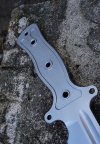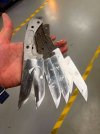So if you apply a bending force to a piece of metal, the piece of metal directly in the middle contributes very little to the strength of the part. It's the material at the edges that resist tension and compression the most. If you want to make something stronger for the amount of weight, remove the material in the middle that isn't contributing much (this is how an I-beam works). The difference between hollowing out the middle of the tang completely and machining a fuller is basically just a little sliver of metal that isn't adding much to the strength, so you might as well cut it all the way through. You'd put a fuller on the blade so as not to create a cutout that can get material stuck in it or snag, but on the tang this isn't an issue since it's covered by the handles.
Also machining a fuller is kind of a pain because you need to use a bullnose end mill on both sides, and run it slow enough to maintain a decent finish. If you're making a cutout and not chamfering it, you can rough it with a waterjet and maybe clean it up on the mill, or wire EDM it and leave as-is.











